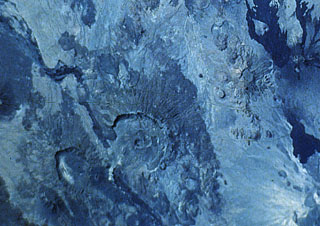Report on Nabro (Eritrea) — 22 June-28 June 2011
Smithsonian Institution / US Geological Survey
Weekly Volcanic Activity Report, 22 June-28 June 2011
Managing Editor: Sally Sennert.
Please cite this report as:
Global Volcanism Program, 2011. Report on Nabro (Eritrea) (Sennert, S, ed.). Weekly Volcanic Activity Report, 22 June-28 June 2011. Smithsonian Institution and US Geological Survey.
Nabro
Eritrea
13.37°N, 41.7°E; summit elev. 2218 m
All times are local (unless otherwise noted)
A satellite image of Nabro acquired on 22 June showed a gas-and-ash plume rising from the caldera and drifting W. According to a news article, the eruption resulted in at least seven deaths, injured many, and displaced thousands in Eritrea, and affected about 5,000 Ethiopians living near the border. Two satellite images acquired on 24 June show the erupting vent, plumes and emissions, and lava flows in detail. One false-color image highlighted hot areas throughout the lava flow and flow front, as well as hot material above the vent. Gas emissions rising from the lava flow were also detected. A natural-color image showed fresh but cooled lava flows in the N part of the caldera. A dark ash plume rose from the vent, and at higher altitudes a plume composed of water vapor and sulfur dioxide drifted W and obscured the active lava flow. Black ash deposits covered the landscape to the S and W. During 22-26 June large amounts of sulfur dioxide in the region continued to be detected by satellite images. Based on analyses of satellite imagery, the Toulouse VAAC reported that during 26-27 June plumes rose to altitudes up to 6.1 km (20,000 ft) a.s.l.
Geological Summary. The Nabro stratovolcano is the highest volcano in the Danakil depression of northern Ethiopia and Eritrea, at the SE end of the Danakil Alps. Nabro, along with Mallahle, Asavyo, and Sork Ale volcanoes, collectively comprise the Bidu volcanic complex SW of Dubbi volcano. This complex stratovolcano constructed primarily of trachytic lava flows and pyroclastics, is truncated by nested calderas 8 and 5 km in diameter. The larger caldera is widely breached to the SW. Rhyolitic obsidian domes and basaltic lava flows were erupted inside the caldera and on its flanks. Some very recent lava flows were erupted from NNW-trending fissures transverse to the trend of the volcanic range.
Sources: NASA Global Sulfur Dioxide Monitoring, Sudan Tribune, Toulouse Volcanic Ash Advisory Centre (VAAC), NASA Earth Observatory

